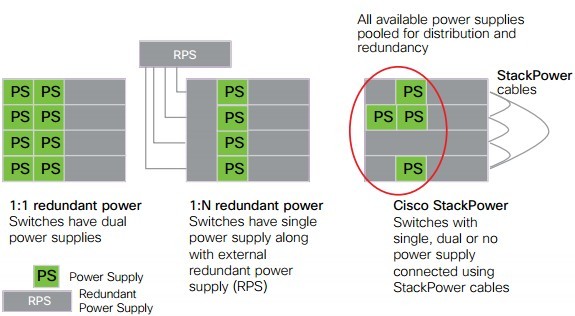
Businesses require a highly available campus network because any downtime can bring down access to phones, wireless access points, and business applications.
Network switch power redundancy is a critical component of overall campus redundancy. There are two commonly used power redundancy solutions for switches: full redundancy and partial redundancy. In full redundancy, every switch is attached to two power supplies so that if one goes down, the other takes over. This scheme is also called 1:1 redundancy. In partial redundancy, there is one extra power supply for multiple switches. This is also called 1: N redundancy. Fully redundant power solutions are often underutilized because every switch has a backup power supply, which is idle under normal conditions. Partially redundant power supply takes time to come online in the event of a power failure, leading to network outages.
Cisco StackPower, Features
Cisco StackPower provides a revolutionary alternative to power redundancy for Cisco access switches. StackPower pools the available power supplies in all the switches and makes them available to every switch. The pooling of power supplies is the most efficient way to distribute the power to every switch. In the event of a power supply failure, excess power from the pool can be redistributed very quickly.
The following figure compares Cisco StackPower with traditional power redundancy schemes for a stack of four switches.

As long as the total available power is more than the power in use, StackPower uses the excess power for redundancy. StackPower allows distribution of power based on switch and port priorities. This is valuable during power outages because if the StackPower pool does not have enough power for all switches, certain devices (for example, wireless access points) connected to certain ports can be kept going until the failed power is restored.
Benefits, Cisco StackPower
- Zero-footprint redundant power supply: No need to set up an external redundant power supply. Adding one additional power supply to any switch in the stack provides redundancy to the entire stack.
- Capital savings: Avoids purchase and installation of redundant power supply. Conserves real estate in wiring closet.
- Operational savings: Cisco StackPower frees administrators from maintaining underutilized redundant power supplies and power shelves.
- Scalability: Up to nine switches can be connected with an expandable power system.
- Ability to assign priorities to switches and ports (connected devices) for higher availability during outages.
Supported Cisco Catalyst Platforms: Cisco Catalyst 3750-X, Catalyst 3560-X
More Cisco StackPower Reviews:


